All businesses ought to have a content marketing strategy in place or risk falling far behind their rivals. A solid strategy will drive traffic to your site to generate leads, help prospects during the buying process, and build relationships with prospects.
But it’s no longer the simple, easy-to-execute tactic it was in the early days of the internet — which means it’s even more important to get it right.
In this guide, we’ll walk you through how to create a content marketing strategy for your business. We’ll discuss what falls under the umbrella of content marketing examples, how it works, content strategy best practices, tools that will help you out, and much more!
Laying Your Foundation
It’s important to note that any successful marketing campaign must first stem from a focused foundation. Without understanding your objectives and your assets, any marketing (inbound or otherwise) can and will suffer from a lack of vital direction. So, before we write our first blog post or start filming our first video, let’s lay that foundation.
TABLE OF CONTENTS:
What Is a Content Marketing Strategy?
First, let’s start with a simple definition.
A content marketing strategy is a plan for creating, publishing and promoting informational content to attract a specific audience with the goal of driving profitable customer action.
This strategy often focuses on consistent content delivery across various platforms to establish authority, build relationships and encourage brand loyalty.
Unlike basic blogging, strategic content marketing encompasses specific goals for everything you create. Brands can choose to make their content free or gated (gated content is when users can only access it after providing their information, like an email address).
Different types of content fall under this umbrella, and each type serves specific goals in a content marketing strategy:
- Blog Posts: Informative articles published on your own site (“owned media”) or as guest posts for other publications that boost SEO and provide valuable information to readers.
- Videos: Engaging visual content for platforms like YouTube, social media, or embedded in websites.
- Infographics: Visual representations of data or information, useful for explaining complex subjects.
- Case Studies: Detailed stories about customer success or product effectiveness.
- E-books: In-depth guides or reports, often used as lead magnets.
- Email Newsletters: Regular updates and valuable content sent directly to subscribers’ inboxes that capture information like a user’s email address.
- Social Media Posts: Content tailored for platforms like Facebook, Instagram, Twitter, LinkedIn, etc., to engage with a community.
- Webinars/Podcasts: Educational or discussion-based sessions providing insights or entertainment to listeners or viewers and help you convey your brand personality.
- White Papers: Authoritative reports or guides on specific topics that present a problem and provide a solution.
- Landing Pages: Hosted on your own site and direct users to click a button to find further information or convert.
- User-Generated Content: Content created by customers, like reviews or social media posts, showcasing real-life experiences with a brand or product.
- Interactive Content: Quizzes, surveys, or tools that engage users and provide personalized value.
- Graphics: High-quality images or custom graphics to support written content and improve visual appeal.
The Importance of a Content Marketing Strategy
A content strategy is more than just producing blog posts and videos. It not only helps achieve business goals, but also provides metrics to measure and then improve those results.
What are some of the business goals that a content marketing strategy can achieve? Content production helps your brand’s website:
- Build Brand Awareness: Consistent, high-quality content helps introduce your brand to new audiences and keeps it top-of-mind for existing customers.
- Establish Authority and Trust: By providing valuable information, insights, or solutions, a brand can establish itself as a thought leader in its industry, building trust with its audience.
- Enhance SEO and Online Visibility: Regularly publishing relevant content improves search engine rankings, making it easier for potential customers to find your business online.
- Generate and Nurture Leads: Content marketing can attract prospects through engaging material and nurture them through the sales funnel with targeted, informative content.
- Improve Customer Engagement and Retention: Quality (key word here) content can keep your audience engaged, encouraging repeat business and fostering a loyal customer base.
- Support Other Marketing Strategies: Content marketing complements other marketing efforts, like social media marketing, email marketing and PPC campaigns, by providing substance and context.
- Cost-Effectiveness: Compared to traditional advertising, content marketing often offers a higher ROI, as it can be less expensive to produce and remains effective over a longer period.
- Data Collection and Customer Insights: Engaging with content allows businesses to gather data and insights about their audience, which can inform future marketing strategies and product development.
Keep in mind that 79% of businesses use a content strategy to attract quality leads. If you produce helpful content, your audience will look to your blog and social media platforms for advice and recommendations.
Once you attract a sale from a lead, your content will continue engaging these customers. These consumers are more likely to engage with your content by commenting and sharing, which is why 63% of marketers use content to build customer loyalty.
Note: It’s worth hiring a content marketing agency to do all the hard work for you once your business starts really growing.
How Does Content Marketing Work for Inbound Marketing?
Inbound marketing attracts organic traffic through engaging, relevant content production. While inbound marketing is about being found by customers, outbound marketing is about actively seeking customers.
A content marketing strategy is one inbound marketing tactic.
High-quality content attracts leads at various stages of the digital sales funnel. Traffic will come to your site from:
- Organic search when your content is optimized well enough to rank high in the SERPs
- Organic and paid social posts
- Social posts that have gone viral or been shared on a smaller scale
- Influencers or bloggers whom you have collaborated with to share branded content
Since a content strategy is about attracting your audience with an inbound strategy via high-value and relevant content, your content must be genuinely engaging, informative, and/or entertaining:

Here are a few stats to back up the effectiveness of content marketing:
- Content marketing ROI is higher than PPC.
- Pages that rank first on Google generate a 29.58% CTR.
- 86% of marketers use video to drive website traffic.
That said, you’ll only get these results if you create content that aligns with your inbound marketing strategy.
Now that you have a clear understanding of why content marketing is so important, let’s go through all the steps required to create a content marketing strategy.
How to Create a Content Marketing Strategy in 10 Steps
Great content is pretty useless without a strategy behind it, and this is one of the biggest marketing objectives that brands should remember.
A successful content marketing strategy is carefully created, documented and executed without deviation. Yet many marketers still don’t have a content strategy at all.
Here’s how to create a content marketing strategy that will work.
1) Analyze Audience Needs and Behaviors
The next step is to know who your target market is, and a great way to know is to create buyer personas. As we said in our blog post on this subject, “Part of the reason marketers fail at persuading buyers is because they see their customers as data points, not as people.”
Every marketer must conduct market research before going forward with a content marketing strategy. But what does “audience research” entail? Content marketers will need to know their audience’s needs as well as the way in which they behave.
This step ensures that you produce valuable content.
To analyze audience needs, demographics, and behaviors, the first step is to collect the right data, including socio-demographic, geographic, psychographic, etc.:

Analyze your audience metrics in the content formats and posts that have performed well. This way, you’ll know who your consumers are and how they react to your content.
2) Do Competitor Content Analysis
Knowing your audience is integral to creating an effective content marketing strategy, but it’s also essential to know what your competitors are doing. That’s because your customers could quickly switch over to a competitor if they feel they’re providing a better experience or a lower cost.
Competitor analysis is extremely important because it will reveal the strengths and weaknesses of your competition so that you know what you’re up against and what it takes to beat them. There are four basic steps to take:
- Step 1: Categorize your competitors on the basis of their weaknesses and strengths. Write down the USP of each and every competitor. Perform a SWOT analysis to closely examine the Strengths, Weaknesses, Opportunities and Threats related to your company:

- Step 2: Analyze their campaigns and social media activities. You can subscribe to their newsletter and follow their social media accounts to see how they interact with the prospects.
- Step 3: Analyze their website and explore their SEO strategies and review their PPC ad copies.
- Step 4: Study their annual sales report that presents information related to total sales volume, revenue increases and the overall market share.
Conducting a competitor analysis will help you determine which content formats they’re producing and what’s working for them. You can measure metrics such as followers, views, likes, comments, shares, and traffic.
Though you can view most of these metrics by glancing at their social media posts and accounts, you’ll need a third-party tool to gauge web traffic and do a more thorough analysis, like (click here to learn how to use these tools for competitor analysis):
3) Choose Your Goals for Your Content
Before setting your content goals, understand your business objectives, assets, and target audience. For example, consider using the SMART framework to set your goals—for instance, “Grow our Twitter audience by 15% over the next 6 months.” This approach not only makes your objectives specific and measurable but also aligns your content strategy with your overall business direction.
A content marketing strategy can help you accomplish various diverse goals. It goes without saying that for most brands, the ultimate goal will always be to engage current and potential customers.
That said, there are different strategic goals to focus on, including:
- Driving immediate sales
- Getting more traffic to your site through social media shares or SEO
- Improving the overall SEO of your site with optimized blog posts, improved CTAs, backlinks, etc.
- Building brand awareness
- Establishing yourself as an industry expert or thought leader
- Generating new leads
- Increasing the number of email subscribers
- Boosting on-site engagement
It’s a good idea to start with one or two goals and then change them or branch out once you’ve seen some good ROI.
In addition, you should:
- Update your older blogs to ensure that the content is current, tackles new industry trends, and offers fresh perspectives.
- Conduct a content audit to match your current goals, track SEO performance, and make sure the page offers a positive user experience.
Set Your Content Marketing KPIs
Your Key Performance Indicators (KPIs) are the essential metrics that you’ll watch to evaluate your progress toward your goals in a content marketing strategy. These need to be specific, measurable metrics that can clearly demonstrate progress.
You can’t improve what you don’t measure.
For example, if boosting lead generation is your goal, you’ll likely use a high-value content format like an e-book and stick it behind a data capture form. To download the e-book, prospects must give you some data — usually name, job title, and email address.
In this case, your KPI could be the “number of downloads” of that e-book. Set a realistic target for this metric (say, 100 per month) and if you hit it, you can be confident that your tactic has taken you further towards your overall goal of gathering 100 more leads per month.
Not sure where to start? Try focusing on these content marketing metrics:
- Organic traffic
- Leads
- Sales
- Page views
- PR citations and placements
- Number of branded keyword searches
- Followers/subscribers
- Time on page
- Click-through rate (CTR)
- Content downloads
- Conversion rate
- Social media engagement
You should also apply these goals to your updated content. When conducting a content audit, keep an eye on issues that could affect the user experience, such as slow page loading speeds. This can impact your lead generation, sales and other goals.
4) Create a Content Lead-Nurturing Funnel
A lead-nurturing funnel is about the big-picture view of the buyer’s journey. It will make your content marketing strategy significantly more effective by helping you work out which pieces of content your leads should be seeing at different stages of their customer journey:
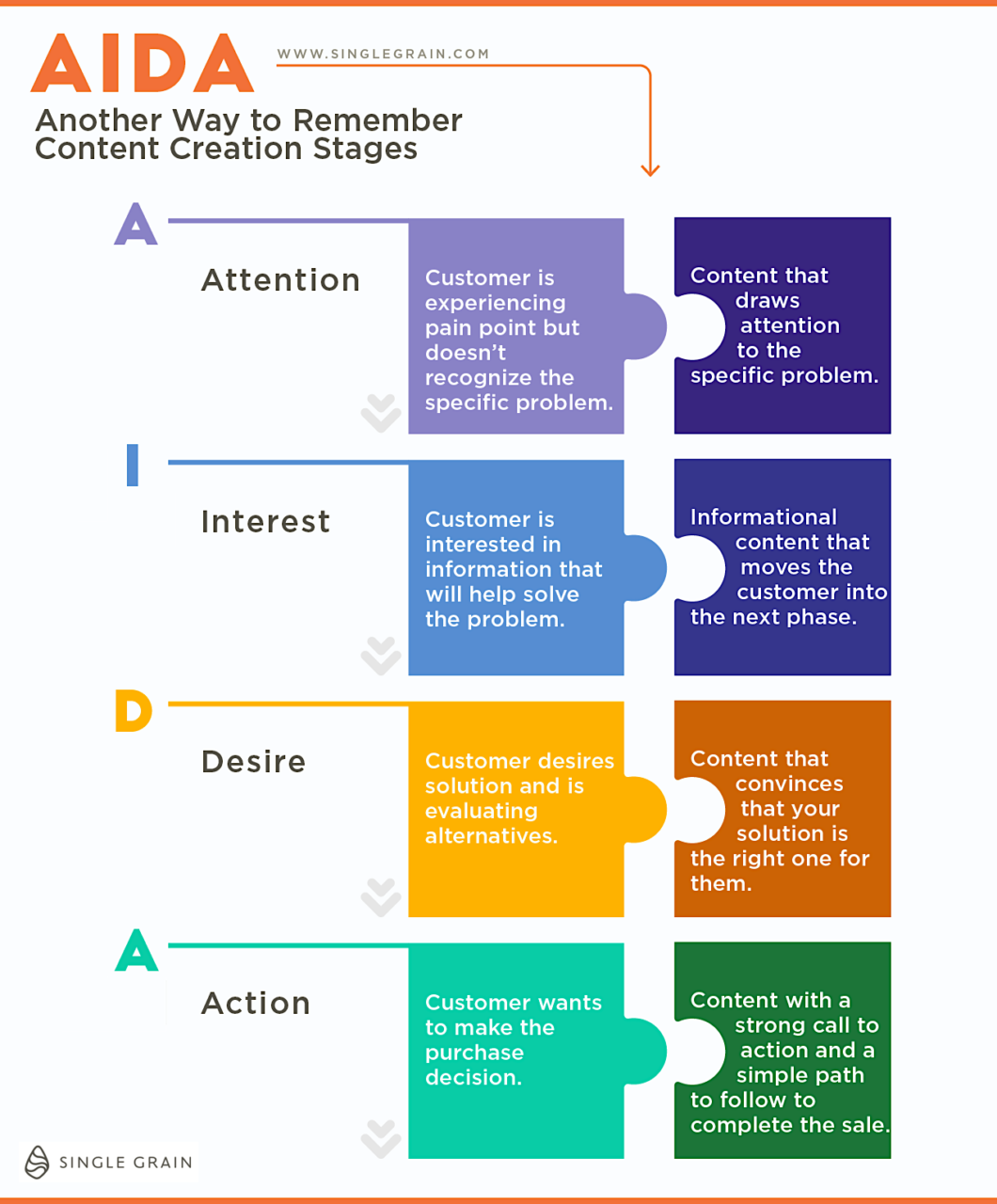
Lead nurturing should be an essential part of your strategy, and you should create different funnels to accomplish different goals (though there can be overlap in content).
Here are the stages in a marketing funnel and the type of content you should create for each:
- Awareness stage: Your audience wants to find a solution to their needs, pain points, questions and challenges. Create content guides, industry reports, educational videos, infographics, and user-generated content.
- Consideration stage: They are now considering the different solutions to their needs. Host webinars and release white papers to gain trust.
- Conversion/decision stage: Your leads are ready to pick a product or service. Release case studies and customer testimonials.
- Loyalty stage: Here is where you should be nurturing relationships with existing customers. Create buyer’s guides, video tutorials, interactive content, and how-to blog posts.
- Advocacy stage: Your most loyal customers have become brand advocates. Reward them with exclusive content, special offer emails, referral programs, and contests.
This is why it’s so important to have a distinct goal and purpose for every single blog post you write.
5) Build a Content Marketing Team
As you can see, a content marketing strategy involves many steps and tactics to dominate search engine results pages. This isn’t a job you can handle alone, so you’ll need to hire or outsource the best talent to create and distribute compelling content:

The different roles involved in content marketing strategies include:
- Writers
- Editors
- SEO pro
- Social media professionals
- Email marketers
- Content strategist
- Project manager
- WordPress admins
- Branding professionals
- Salespeople
- Product researchers
- Demand gen and lead gen professionals
There are numerous roles, and not all businesses have the budget for all of them, so often one person will wear different hats. But you should at least start by hiring these key players:
- Content strategist: Manages your entire content marketing plan. They will create processes around your content, create/edit/design your content based on audience needs, publish these pieces, and track metrics and goals to ensure excellent content performance.
- SEO strategist: Optimizes your content for search engines. You can also use SEO services for this role.
- Content creators: Generates the content you’ll use in your strategy. These roles include writers, graphic designers, and video creators.
- Editors: Reviews your content to make sure it meets your quality standards and is error-free.
- Social media manager: Uses different social media platforms to promote your brand, create content, and build an audience.
Align with Your Team
Executing a successful content marketing strategy requires a collaborative effort from your team. Whether you work with contractors, freelancers or have a dedicated in-house content team, ensuring alignment and open communication is vital for achieving your content goals.
One of the first steps in fostering team alignment is establishing regular communication channels. Schedule weekly or biweekly meetings where team members can come together to discuss insights, share ideas and provide updates on their progress.
During these meetings, it is essential to provide a clear vision for your content marketing strategy. Communicate your goals and expectations to ensure that everyone understands the direction and purpose behind the content initiatives. Encourage the entire team to ask questions, seek clarifications and offer their thoughts or insights.
To make this easy, use project management platforms, such as Trello or Asana, to assign tasks, track progress and provide visibility into ongoing projects:

These tools help keep everyone informed and organized on their respective responsibilities, contributing to the overall alignment of the team.
6) Content Ideation and Planning
Once you have a team that includes a variety of people, from writers to SEOs to marketers, this is a good time to start ideation. During content development, you must collaborate on content strategy ideas to resonate with your audience. There are many places to start, such as:
- Researching trending topics in your niche
- Discovering topics that are well-liked among your audience
- Trying different content formats, like blog posts, infographics or short-form videosConsider exploring emerging content formats such as podcasts and YouTube ‘Shorts’. Podcasts have seen a significant rise in popularity, offering an intimate way to engage with your audience through in-depth discussions, interviews or storytelling. YouTube ‘Shorts’, on the other hand, cater to the growing demand for short-form video content, allowing you to share quick, engaging clips that capture attention.Keeping up with these trends enables you to meet your audience where they are and experiment with new ways to deliver your message.
- Ideate blog post and video titles that will generate clicks
- Decide on posting frequency and editorial calendar generation
- SEO tactics, such as keyword research and link-building
- Planning for the distribution of your content
- Finalizing the metrics you’ll track
You’ll also want to plan the technology for your content marketing strategy. For example, decide in advance whether or not you’ll use AI tools and how to apply it to any of these stages of your content.
7) Create Your 10X Content
Now that you’ve added all your relevant content ideas to your editorial calendar, all brands must focus on creating pieces that are better than what’s already ranking. This is called creating “10X content,” which encourages marketers to rise above the competition and dominate SERPs:
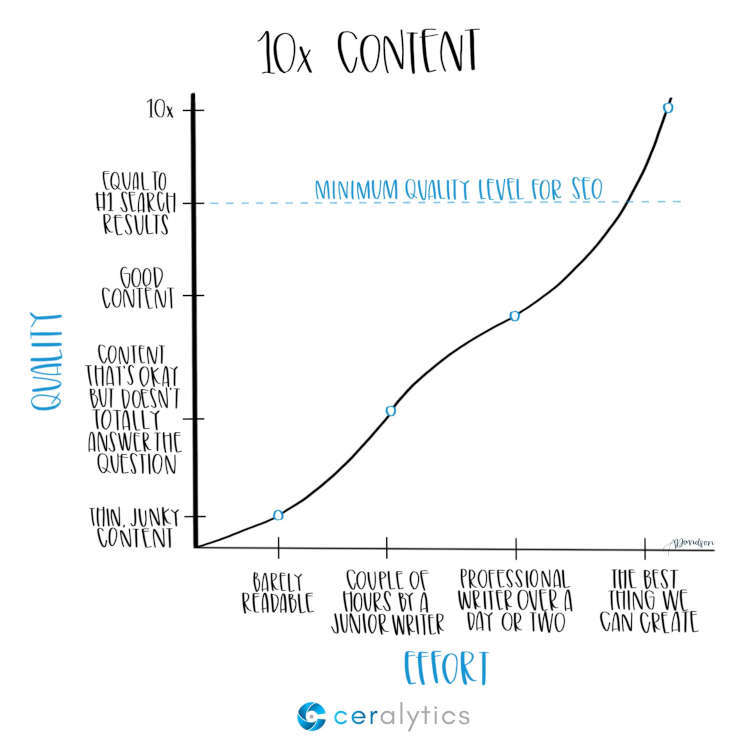
How can marketers achieve this goal of creating 10X content? Here are some tips:
- Diversify Your Content: Working with different content types at various stages of the buyer’s journey since different types of content will attract those in the consideration stage versus those about to make a purchase.
- Consider Content Localization: It’s easier than ever to make your content accessible worldwide in multiple languages thanks to AI translation tools. When done right, a good content localization strategy can make your content seem like it was originally made for a specific locale. Popular YouTuber MrBeast has used this strategy with great success:
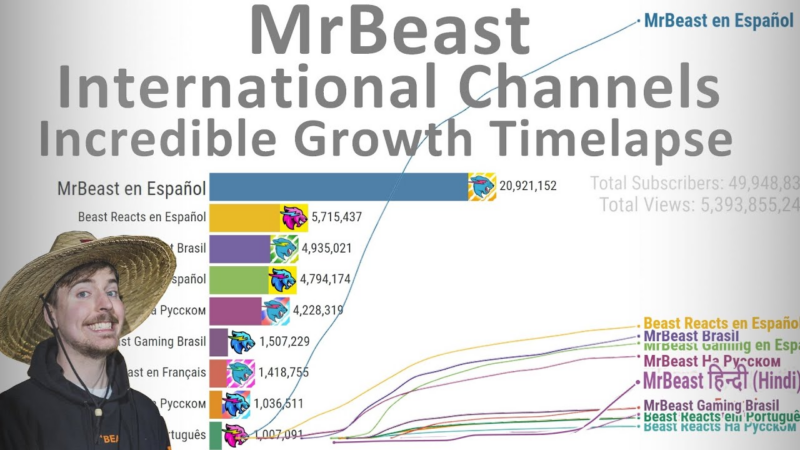
- Focus on Originality: Creating content that is unique compared to what your competitors are posting.For instance, fashion e-commerce brands are embracing augmented reality (AR) to enhance the shopping experience. By allowing customers to virtually try on clothes or accessories through AR apps, brands are offering a unique and interactive way to shop online. This use of cutting-edge technology not only sets the brand apart from competitors but also provides practical value to customers.
- Post User-Generated Content: When you put content creation in the hands of your audience, it improves your reputation.
- Repurpose Content: You should also use the 10X approach to repurpose existing content to appeal to new audience members:
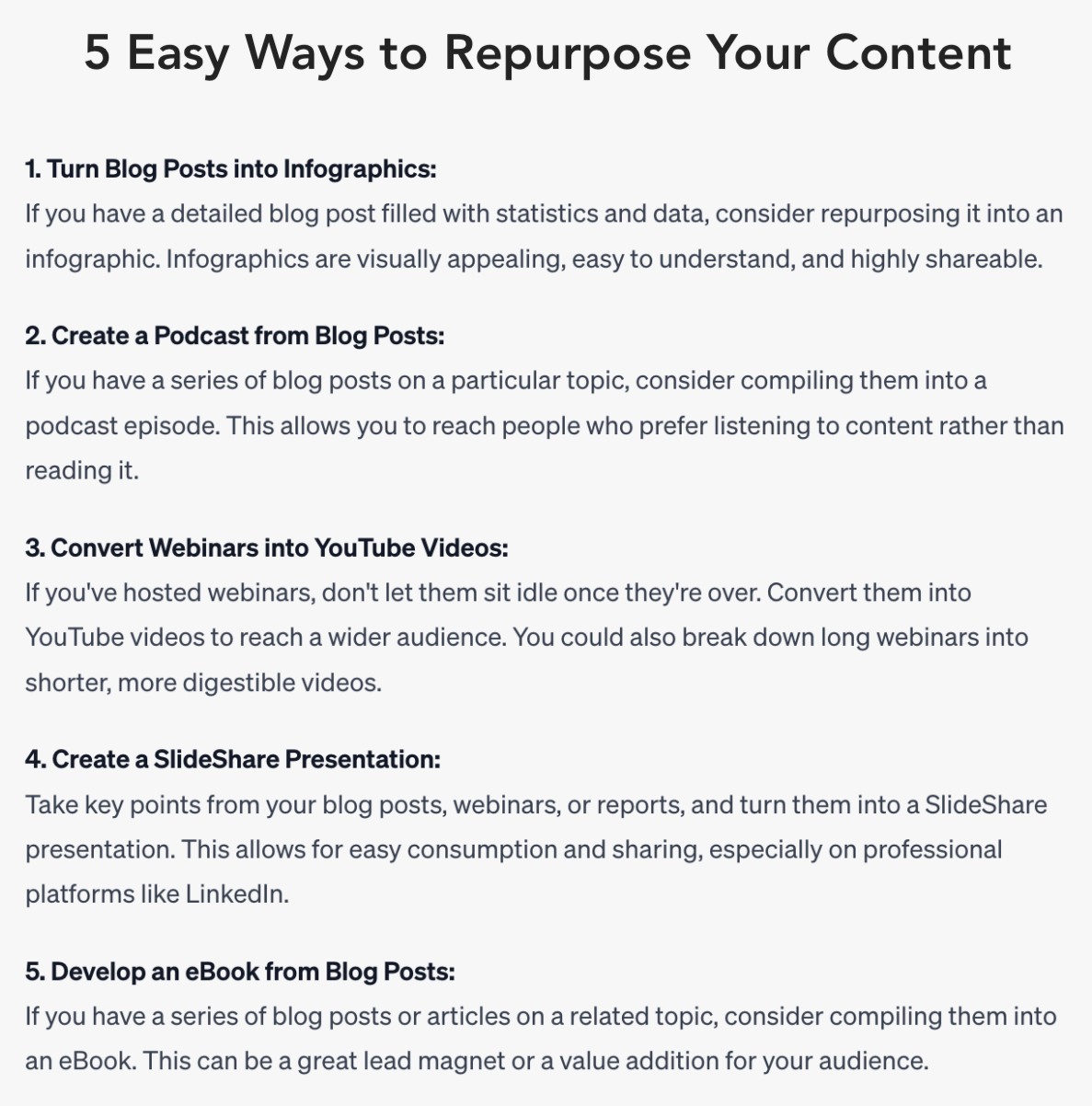
Be Both Informative and Relatable
To captivate and engage your audience, it’s crucial to align your content with popular culture – in other words, be relatable to your audience.
By staying in tune with what is currently buzzing in the market, you can create content that resonates deeply with your target audience. One powerful example of this approach can be seen in the content strategies of influential figures like Billy Gene.
Billy Gene, renowned for his marketing expertise, understands the importance of integrating marketing concepts into everyday life:
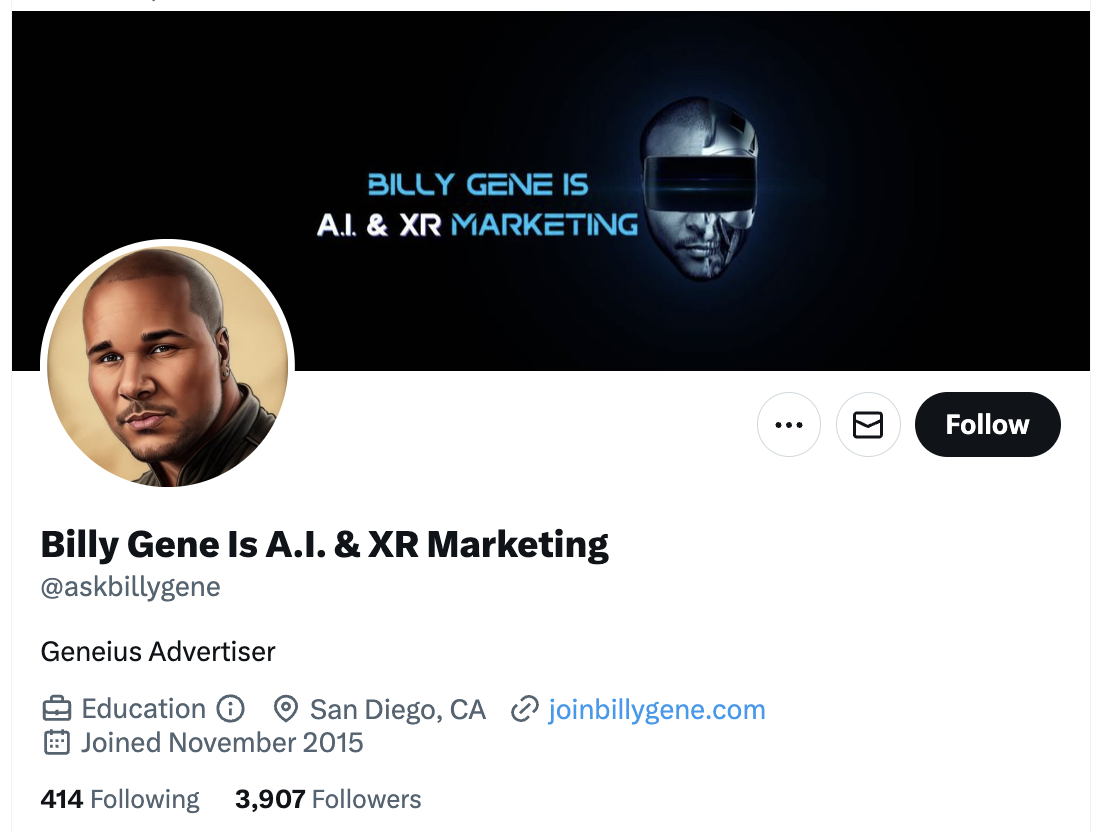
He recognizes that people are not solely interested in business-related content, but also in how marketing impacts their daily experiences.
In discussing the financial success of Mariah Carey’s Christmas song or analyzing the impact of popular Netflix series, he manages to blend marketing insights with popular culture. This approach allows him to connect with his audience on a personal level, making his content both informative and relatable.
When you intertwine relevant news with your storytelling or your own take on it, you create a captivating narrative that captures your audience’s attention from the get-go. By addressing topics that are already on their minds or that they are actively discussing, you demonstrate your understanding of their interests and concerns.
Content Marketing Tools to Streamline the Process
If a content strategy feels a little overwhelming, that’s because there’s a lot to keep up with! That said, the right software can improve content strategy efficiency. The following tools will help you streamline the process and improve your content performance.
Research Tools:
- Ahrefs – Consists of various tools that can aid your content strategy, content calendar, and SEO efforts. You can use the Keyword Explorer tool to research and receive search term suggestions, the Site Explorer tool to view your metrics and conduct competitor research, and explore ideas for blog posts with Content Gap.
- Answer the Public – Finds autocomplete data from Google and recommends questions and useful phrases.
- Google Trends – Analyzes the popularity of common search terms.
Planning Tools:
- HubSpot Marketing Hub – Creates a lead generation workflow to score and nurture leads so that you can plan your content around your unique audience.
- Gather Content – A tool that organizes content ideas and aids creation.
- Airtable – An editorial calendar and project management tool that helps you keep track of your campaign, content, tasks, and publishing dates. Plus, you can communicate with team members on the platform.
Collaboration Tools:
- CoSchedule – This tool allows you to write WordPress posts, assign authorship, add tags and categories, and even schedule social sharing all in one dashboard. They also have great analytics, which is a plus.
- Slack – A godsend when a marketing team is working remotely, as it allows for easy and intuitive communication and work scheduling.
- Asana – Another favorite when it comes to straightforward project management.
Social Scheduling Tools:
- Agorapulse – Includes everything you need for a robust social media marketing campaign, such as publishing, reporting, monitoring, and listening.
- Hootsuite – For in-depth analytics and publishing abilities.
- Sprout Social – Offers powerful features such as scheduling and analytics.
SEO Tools:
- Yoast SEO – WordPress plugin to ensure that my content is readable by both humans and Google.
- Moz – offers actionable SEO insights and plenty of data to easily track results.
- SimilarWeb – View stats for your website and competitors.
Writing Tools:
- Grammarly – Flags any mistakes and offers word swap suggestions.
- Semrush SEO Writing Assistant – A mix of an SEO plugin and a writing assistant, and it will review your content for overall readability and SEO-friendliness even when you’re writing in Google Docs.
- Scrivener – Writing and outlining aid that manages notes, documents, and metadata. Includes many programs, such as corkboard, a visual-based tool to help with outlining.
AI Tools:
- ChatGPT – Generates human-like text based on prompts, questions, queries, and transcriptions.
- Perplexity AI – One of the most robust and natural LLMs out there, capable of producing some of the most fluid copy.
- Copy.ai – Business-forward AI writer with an Infobase, the capability to replicate your brand, team features, and a chatbot.
- Phrasee: Uses AI optimization to personalize your content.
- SEO.ai: Makes SEO content generation a breeze.
8) Optimize Your Content
Earlier you created goals for every single post that you write, infographic that you design or video that you create. Now is the time to make sure that you align those content goals with the content creation (before you publish it is better, but you can always optimize your older content after it’s published).
Specific actions you can take to optimize your posts based on your specific goals include:
- Sales: Mention products in your posts and include a link to any relevant internal links and a well-placed CTA.
- Site traffic: Optimize your content for the SERPs to increase organic traffic. Create an effective content distribution strategy and encourage social sharing to attract more organic traffic in the awareness stage.
- Brand awareness and thought leadership: Link to other content you’ve written and engage with other thought leaders and influencers.
- On-site engagement: Make it easy for users to comment on your site. Disqus is a great tool for this, and it’s a plugin that’s particularly good at generating comments and actual discussions.
- Optimize for SERPs: In addition to linking your content to other high-value, high-authority sites, follow these tips:
- Keyword research: Identify the keywords your target audience uses to search for information, and include those keywords throughout the blog post. Helpful tools include Google Keyword Planner, Semrush and Ahrefs.
- SEO: To give your content the best chance of ranking well in the search engines, optimize title tags, meta descriptions, headings, and ensure keyword density. Helpful tools include Yoast SEO (for WordPress), Moz and Screaming Frog SEO Spider.
- Content quality: Creating high-quality content means it should be clear, error-free and easy to read. Helpful tools include Grammarly and Hemingway App.
- Multimedia: Incorporate images, videos and infographics to make content more engaging. Helpful tools include Canva and Adobe Spark for creating visual content, and Lumen5 to turn text content into engaging videos.
Integrate CTAs Throughout Your Content
Our next tip is all about weaving your CTA into your content, which people tragically don’t do nearly as often as they ought.
Integrating effective calls-to-action throughout your content can significantly enhance your overall strategy. Surprisingly, many companies miss out on leveraging this opportunity, confining CTAs to the traditional locations of sidebars, headers, and footers.
Here’s why and how you should integrate CTAs throughout your content:
- Maximize Conversion Opportunities: Placing CTAs within your content allows you to seize conversion opportunities at various touch points. While it’s important to have CTAs in standard locations, integrating them naturally within your content presents a greater chance to capture the attention and interest of your audience. Look for breaking points in your content where someone might naturally stop reading and place your CTA there.

- Create a Sense of Urgency: When crafting CTAs, ensure that they are highly relevant to the context of your content. Tailor your CTAs to align with the specific topics or solutions discussed, making them more compelling and enticing for readers. For example, while writing a blog post on marketing, you might include a CTA like, “If you want our team to handle it all for you, check out our agency.”
9) Devise a Content Marketing Distribution Plan
Too much great content goes undiscovered online because the writer/business/marketer didn’t have a distribution plan. Even if your site has an incredibly high site authority, your target audience may not find your content through search engines.
When it comes to content distribution, you need to be both proactive and intentional. The goal is to attract users to your landing page (ideally within your target audience), so you’ll want to get your content in front of as many eyes as possible.
Here are some distribution channels to add to your own content marketing strategy:
- Social Media: Sharing your content on social media platforms is the bread and butter of distribution — it should be your first port of call whenever a new post has gone live:
- Guest Posting: Getting your content on relevant, high-value sites allows you to not only build your reputation and brand awareness but also to link back to your own content. This can send interested traffic to your website and then keep visitors exploring your content for a little while.
- PPC Campaigns: You can use Google Ads to help your content climb to the top of the SERPs in relevant searches. You can also use Facebook Ads and LinkedIn Ads to put your content directly in front of your desired audience. These tools split audiences up by targeting criteria like interest, demographics, or even their relationship with your business.
- Email Marketing: Personalize and segment your content for an email newsletter. Tailor your subject line to match with the content.
Ensuring that your plan covers multiple distribution methods will help you cover all your bases to reach the most potential customers, which is exactly what you want.
Collaborate with Influencers
Imagine teaming up with an influential figure in your industry to create joint content and cross-promote it on your social media channels.
When you partner up with a known media personality, you can leverage each other’s strengths, expertise and audience reach to create a powerful synergy. This collaboration not only introduces your brand to a wider audience, but also adds an element of credibility and authority to your content.
When you collaborate with influencers, you form (hopefully) long-term partnerships that can create stronger results:
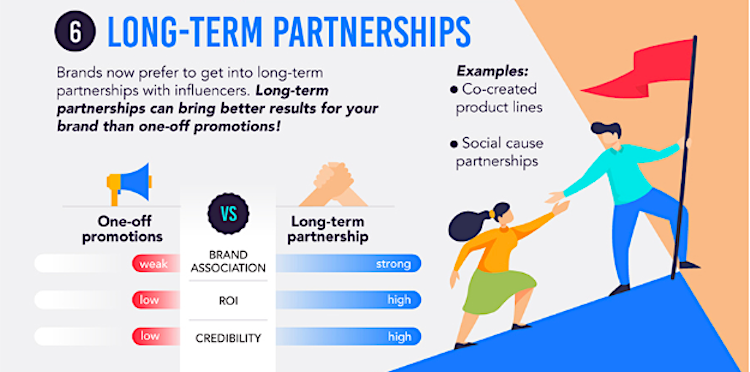
Moreover, collaborating with influencers allows you to tap into their unique creative perspectives and expertise. Influencers often possess a deep understanding of their audience’s preferences, needs and pain points.
Their insights can help you tailor your content to resonate more effectively with the target audience.
10) Track Your Results
Once your content marketing strategy is up and running, it’s time to implement KPI tracking. Keep a close eye on which content is performing best:
- Do shorter videos get more results than longer ones?
- Do infographics get more social media shares than text-based articles?
- Do certain types or topics of posts receive more clicks on the CTA?
To track KPIs, you need to right tools. For many marketers, Google Search Console and Google Analytics are their BFFs. They’re both free and easy to install, and GA goes into great detail about everything happening on your site, including where you’re getting your traffic from, which pages attract the most potential customers, how they’re moving through the site, and how long they stay.
The screenshot below shows the Acquisition section of the tool – a great place to see which medium or source is bringing in the most traffic, how many were new readers (very important!), the highest and lowest bounce rates (low is better), and any conversions you’re tracking:

Note: Regarding KPIs — while more traffic is incredibly important, the quality and engagement of that traffic are equally or more so.
Look for trends in performance and see if you can find reasons why some posts, lead magnets or videos do well when others don’t. A/B testing is a huge help here.
You should also look at the behavior flow dashboard to see how people are moving through your site:

Watch for big drop-off points that stop before or at the lead magnet to troubleshoot your funnel.
Ahrefs is also a tool for measuring content strategy goals. In addition to website traffic, you can use the Site Explorer tool to view your domain rating, backlinks, keywords, top pages, and competitors:

Check out this post for 9 Alternatives that Are Just as Good as Google Analytics.
11) Leverage the Power of AI for Enhanced Content
With how prevalent AI has become in numerous verticals, it behooves us to include it here.
But we’re not just adding it here because it’s trending. We actually believe it’s worth your while to use AI tools to a certain extent.
AI tools like ChatGPT and Jasper AI offer immense potential for upgrading the quality of your content and captivating your audience. Here’s how you can leverage AI to take your content marketing to new heights:
- Foundation: AI-generated content can serve as a solid foundation for your creative process. Use AI tools to generate initial ideas and identify key points that resonate with your target audience. However, remember that AI is a tool, not a substitute for human creativity.
- Quality: AI can help you refine your content and make it more compelling. Use AI to improve grammar, structure, and readability, ensuring that your content is polished and professional. Take advantage of AI-powered language suggestions to enhance your writing style and captivate readers.
- Relevance: AI tools can provide valuable insights into trending topics and popular search queries. This enables you to create content that remains relevant and resonates with your audience, driving higher engagement and organic traffic.
- Authenticity: While AI can assist in content creation, it’s crucial to maintain a human touch throughout the process. Inject your unique voice, personality, and expertise into the content to establish a genuine connection with your readers. Remember, authenticity and relatability are key to building trust and loyalty.
- Adaptation: The field of AI is rapidly evolving, and new tools and techniques emerge frequently. Stay updated with the latest advancements and explore new AI-powered content marketing tools. Learn to leverage the capabilities of artificial intelligence to create content that surpasses expectations and sets you apart from the competition.
12) Discover Content Gaps and Generate New Traffic
With content marketing, it’s not enough to follow the crowd.
To truly make an impact and attract new audiences, it’s crucial to identify and capitalize on content gaps that your competitors may have overlooked:
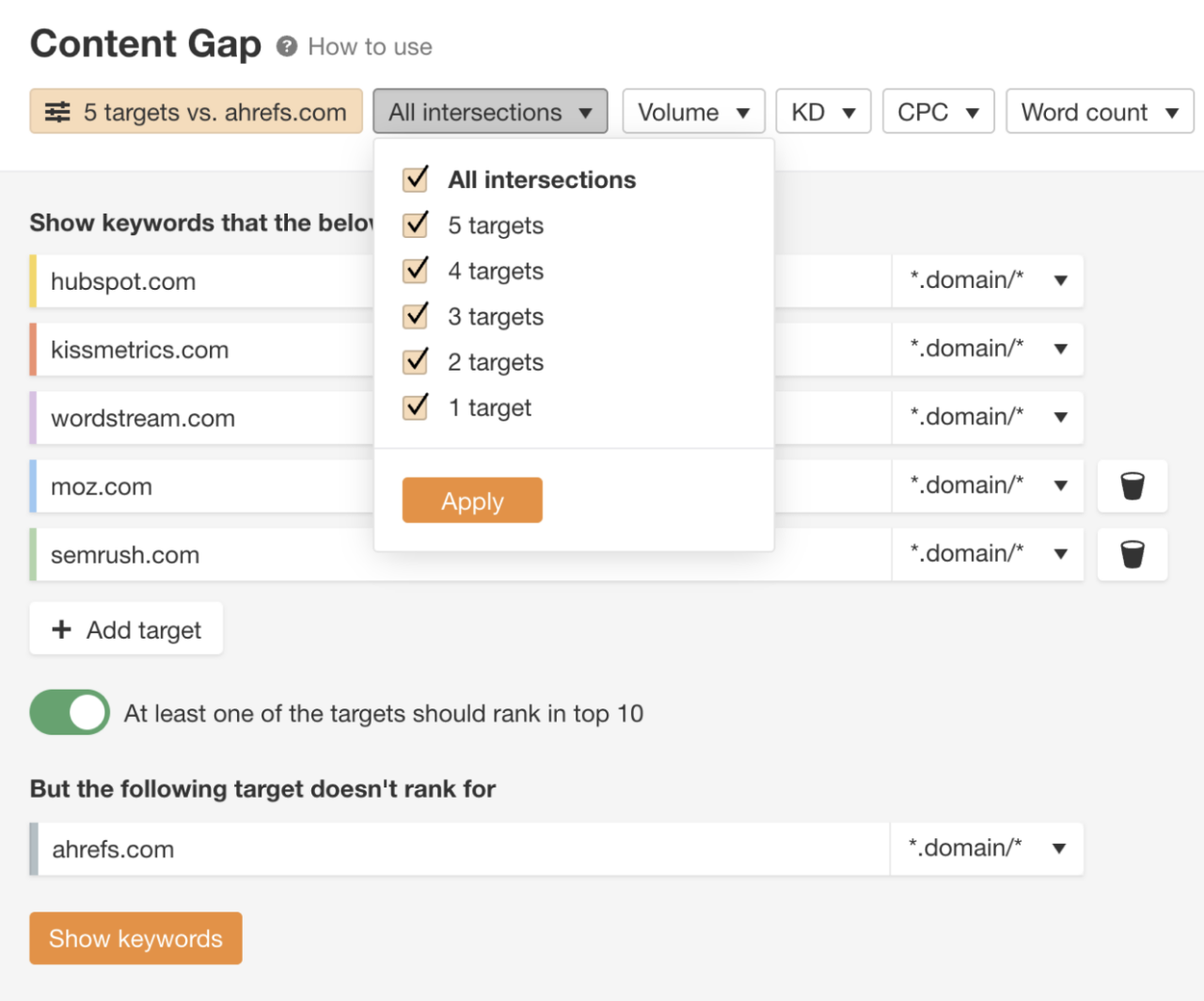
You ought to venture off the beaten path and offer a unique take on something germane to your industry. That way, you’ll pique the curiosity of audience members who have been hearing the same things from other sources.
Here’s how you can discover content gaps and leverage them to your advantage:
- Avoid Repetition and Regurgitation: Rather than recycling the same information that’s already available, strive to provide something fresh and distinctive. Analyze the content landscape in your industry and identify areas that your competitors haven’t extensively covered. This could involve delving deeper into specific subtopics, exploring emerging trends, or presenting alternative viewpoints.
- Identify Untapped Topics and Areas: Conduct thorough research to identify untapped topics or areas within your industry. Explore niche subjects that haven’t received much attention or uncover aspects that have been overlooked by your competitors. This could involve conducting keyword research, studying customer queries and pain points, or engaging in conversations with your audience through surveys or social media interactions.
- Provide Valuable and Actionable Content: When addressing content gaps, focus on providing valuable and actionable insights to your audience. Go beyond surface-level information and offer practical tips they can use.
- Stay Agile and Innovative: The content marketing landscape is constantly evolving. What may be a content gap today might be filled tomorrow. To stay ahead, maintain a proactive and agile approach. Continuously monitor industry trends, follow conversations in your niche, and adapt your content strategy accordingly.
Content Marketing Mistakes to Avoid
We’ve covered everything you should do to ensure a successful content marketing strategy. Now, almost as importantly, let’s consider what not to do.
Some of the biggest content strategy mistakes you can make are:
- Not conducting audience research. To create content that will drive action, you must know basic information about your potential customers, their pain points, and the solutions they need.
- Not experimenting with different languages and content localization. Only around 1.5 billion people in the world speak English, so by limiting your content options to just one language, you’re excluding 80% of the world population.
- Not defining a consistent brand voice. Articulating your brand’s voice should be done in part based on who you are and in part based on audience research.
- Relying exclusively on SEO as a distribution method. Use other distribution methods like emailing your subscriber base, social media sharing, and paid advertising campaigns.
- Not choosing strategic goals for each individual post. Each post should be written with lead generation, product promotion, and on-site engagement in mind.
- Forgetting to link to your own content. Each blog post should contain 3-5 internal links to your content and/or product pages. This keeps people bouncing around on your own site instead of bouncing off of it.
- Forgetting to link to other people’s content. Sending users to other sites is a good SEO move, as it shows users that you can back up your statements with legitimate sources, and can even foster positive relationships with other industry influencers.
- Ignoring advances in automation. There are so many automation tools that can boost the power of your marketing team and allow you to massively scale up without the need to expand your team.
- Not producing content consistently. According to Service Direct, only 57% of small businesses report doing any content marketing efforts. Don’t make the mistake of being one of them. If you forget to post content, have an organized content calendar as a reminder.
- Updating content too frequently. There is too much of a good thing in this case. While content updates are an effective part of a strategy, updating content constantly can have SEO consequences. Only update content to freshen outdated information or better abide by Google algorithm changes.
- Clickbait. These titles and articles may result in increased traffic but don’t build trust among customers.
- Not hiring or outsourcing the right talent. Content marketing tactics are specialized skills, and onboarding the wrong professionals can damage your campaign.
Each of these mistakes can be exceptionally detrimental to your overall results and the effectiveness of your campaigns, so avoid them at all costs!
Final Word on Content Strategy
Creating a content marketing strategy is now a non-negotiable part of running a business, and it’s getting more sophisticated by the day. Creating content directed to your target audience at different stages of the nurturing funnel is no easy job.
But the best chance of achieving a successful content marketing strategy is ensuring you know your target audience inside and out and follow the best content creation processes.
Do this and you’ll start to see improvements in traffic, engagement, and conversion, which you can build on for true SEO content strategy success!
If you need help creating a conversion-driven content marketing strategy that gets you those leads, Single Grain’s content marketing experts can help!👇
Frequently Asked Questions About Content Marketing Strategy
-
How Long Does It Take to See Results From a Content Marketing Strategy?
It typically takes 3 to 6 months to start seeing significant results from a content marketing strategy. This timeline depends on factors like the competitiveness of your industry, the quality of your content, and the consistency of your content production. SEO-driven content may take longer to rank on search engines, while paid social media content can yield quicker results. Patience and persistence are key when measuring the ROI of content marketing.
-
How Often Should I Update My Content Marketing Strategy?
You should review and update your content marketing strategy at least once per quarter to ensure it aligns with evolving industry trends, algorithm changes, and business goals. Regular updates also ensure that your content remains relevant to your audience. You should also refresh individual content pieces when they start to experience traffic drops, as part of your content decay strategy.
-
How Can I Measure the Success of My Content Marketing Strategy?
To measure the success of your content marketing strategy, track key performance indicators (KPIs) like organic traffic, conversion rates, click-through rates (CTR), lead generation, social shares, and backlinks. Use tools like Google Analytics, Google Search Console, Ahrefs, and HubSpot to monitor these metrics. Analyze user behavior, such as time on page and bounce rate, to identify areas for improvement.
-
What Types of Content Should I Prioritize in My Content Marketing Strategy?
The type of content you prioritize depends on your business goals and target audience. However, blog posts, videos, infographics, e-books, and case studies are common staples of successful content marketing strategies. If you’re looking to build authority, consider white papers and in-depth guides. For lead generation, use gated content like e-books or webinars. For engagement, leverage video content, social media posts, and user-generated content.
-
How Can I Identify Content Gaps in My Content Marketing Strategy?
To identify content gaps, start by conducting a competitor analysis using tools like Semrush, Ahrefs, and Google Search Console. Look for topics that your competitors rank for but you do not. Analyze customer feedback, comments, and FAQs to uncover unanswered questions. You can also review your internal site search data to see what visitors are searching for on your site. Filling content gaps allows you to attract new audiences and rank for untapped keywords.
Related Video
For more insights and lessons about marketing, check out our Marketing School podcast on YouTube.
Additional content contributed by Stephanie Jensen and Samuel Pak.






